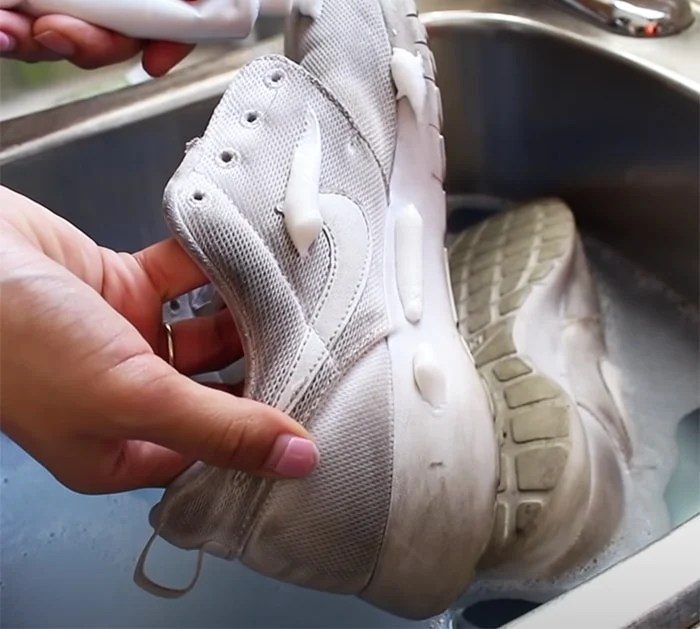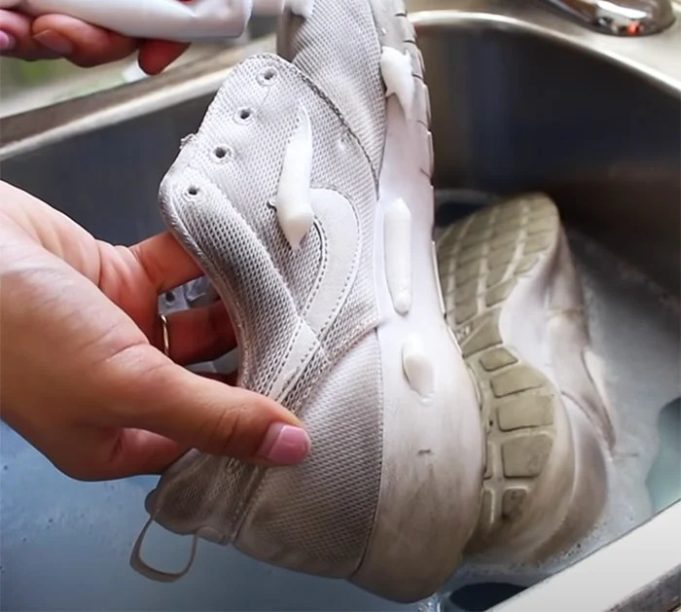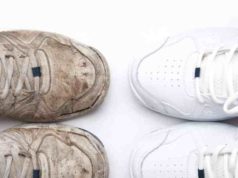How to clean dirty white shoes: a question that plagues many shoe lovers. White shoes, with their pristine elegance, are susceptible to stains and discoloration. But fear not, restoring your white kicks to their former glory is achievable. This guide delves into the secrets of cleaning white shoes, offering a comprehensive approach to tackle dirt, grass stains, scuffs, and even yellowing.
From essential cleaning supplies to effective techniques, we’ll cover everything you need to know. Whether you’re dealing with canvas sneakers, leather boots, or delicate fabric shoes, this guide provides tailored solutions to ensure your white shoes remain sparkling clean.
Understanding the Challenge

Keeping white shoes pristine can be a real challenge. The bright white canvas makes every speck of dirt and stain highly visible, and finding the right cleaning method without damaging the material can be tricky.
Common Stains on White Shoes
Stains on white shoes are inevitable. Here are some common culprits:
- Dirt and grime: This is the most frequent offender, especially if you wear your white shoes often. The accumulation of dirt and dust can quickly dull the white and make them look dingy.
- Grass stains: These are particularly stubborn and can leave behind green or brown marks. They are common for athletes and anyone who enjoys outdoor activities.
- Scuffs: These are common on the toes and sides of shoes from rubbing against surfaces. Scuffs can range from light marks to deep scratches.
- Yellowing: Over time, white shoes can start to yellow, especially if they are exposed to sunlight or sweat. This discoloration can make them look old and worn.
Types of White Shoes and Their Cleaning Needs
Different types of white shoes require different cleaning approaches.
- Canvas shoes: These are generally the easiest to clean, as they can withstand more aggressive cleaning methods. However, they are prone to absorbing stains, so quick cleaning is essential.
- Leather shoes: These require more delicate care. Leather is susceptible to cracking and damage if cleaned improperly. Specialized leather cleaners and conditioners are recommended.
- Synthetic shoes: These are often made from materials like nylon or polyester. They are generally easy to clean but may require specific cleaners designed for synthetic materials.
Essential Cleaning Supplies
Cleaning white shoes requires the right tools and supplies to effectively remove dirt and stains. A well-equipped cleaning kit will make the process easier and more successful.
Essential Cleaning Supplies for White Shoes, How to clean dirty white shoes
A variety of cleaning agents and tools can be used to clean white shoes effectively. Here is a comprehensive list of essential supplies:
| Cleaning Agent | Description | Usage | Safety Precautions |
|---|---|---|---|
| Baking Soda | A natural abrasive that helps remove dirt and stains. | Mix baking soda with water to form a paste. Apply the paste to the shoe using a toothbrush. Let it sit for a few minutes before scrubbing. | Avoid contact with eyes and skin. Keep away from children. |
| White Vinegar | A natural disinfectant that helps remove odors and brighten white shoes. | Mix white vinegar with water in a 1:1 ratio. Dip a soft cloth in the mixture and wipe down the shoes. | Avoid contact with eyes and skin. Keep away from children. |
| Dish Soap | A gentle cleaning agent that helps remove dirt and grime. | Mix a few drops of dish soap with water. Dip a soft cloth in the mixture and wipe down the shoes. | Avoid contact with eyes. Keep away from children. |
| Toothbrush | A small brush that helps to scrub away dirt and stains from the crevices of the shoe. | Use a soft-bristled toothbrush to scrub the shoe gently. | Avoid using a hard-bristled toothbrush, as it can damage the shoe. |
| Soft Cloth | A soft cloth that helps to wipe away dirt and grime from the shoe. | Use a clean, soft cloth to wipe down the shoe. | Avoid using a rough cloth, as it can damage the shoe. |
| Magic Eraser | A melamine foam eraser that helps to remove stubborn stains. | Wet a Magic Eraser and gently rub it on the stained area. | Avoid using a Magic Eraser on delicate materials, as it can damage the shoe. |
| Laundry Detergent | A cleaning agent that helps to remove dirt and grime from the shoe. | Mix a small amount of laundry detergent with water. Dip a soft cloth in the mixture and wipe down the shoes. | Avoid contact with eyes and skin. Keep away from children. |
| Hydrogen Peroxide | A bleaching agent that helps to brighten white shoes. | Mix hydrogen peroxide with water in a 1:1 ratio. Dip a soft cloth in the mixture and wipe down the shoes. | Avoid contact with eyes and skin. Keep away from children. |
Cleaning Techniques
Now that you have gathered your supplies, let’s dive into the actual cleaning process. Cleaning white shoes requires a systematic approach to ensure they are thoroughly cleaned and restored to their pristine white glory.
Pre-treatment
Pre-treatment is crucial for removing loose dirt and debris and preparing the shoes for a deep clean. This step helps to prevent further staining and ensures that the cleaning agents can effectively penetrate the shoe material.
- Removing Loose Dirt and Debris: Before applying any cleaning agents, use a soft-bristled brush or an old toothbrush to remove loose dirt, dust, and debris from the surface of the shoes. Pay attention to the grooves and crevices where dirt tends to accumulate.
- Pre-treating Stubborn Stains: For stubborn stains, apply a stain remover specifically designed for footwear. Follow the instructions on the product label carefully. Apply the stain remover directly to the stain and let it sit for a few minutes before proceeding to the next step.
Washing
Washing your white shoes is an essential step in restoring their whiteness. Depending on the material of your shoes, you can choose between hand washing, machine washing, or using a cleaning solution.
- Hand Washing: For delicate white shoes, hand washing is recommended. Fill a basin with lukewarm water and add a mild detergent. Gently scrub the shoes with a soft-bristled brush, focusing on the areas with stains. Rinse the shoes thoroughly with clean water until all the soap residue is gone.
- Machine Washing: For sturdier white shoes, machine washing is an option. Place the shoes in a mesh laundry bag to protect them from damage during the washing cycle. Use a gentle detergent and a cold water setting. Avoid using bleach as it can damage the fabric and cause discoloration.
- Using a Cleaning Solution: Alternatively, you can use a commercial cleaning solution specifically designed for white shoes. Follow the instructions on the product label carefully. Apply the solution to the shoes with a soft cloth or sponge and scrub gently. Rinse the shoes thoroughly with clean water.
Drying
Proper drying is essential to prevent mold and mildew growth and to maintain the shape of your white shoes. Air drying is the most effective method, but it is important to avoid direct sunlight.
- Air Drying: After washing, allow the shoes to air dry completely. Avoid direct sunlight as it can cause discoloration and damage the fabric. Stuff the shoes with newspaper or paper towels to absorb excess moisture and maintain their shape.
- Reshaping: Once the shoes are completely dry, reshape them to their original form. Use a shoe tree or a rolled-up towel to help maintain their shape. Avoid using heat sources such as hair dryers or radiators as they can damage the shoes.
Preventing Future Stains: How To Clean Dirty White Shoes
Now that you’ve learned how to clean your white shoes, let’s discuss how to prevent those pesky stains from happening in the first place. By taking some proactive steps, you can keep your white kicks looking fresh and bright for longer.
Using Shoe Protectors and Waterproofing Sprays
Applying a protective layer to your shoes can act as a shield against dirt, water, and other stains.
- Shoe protectors create a barrier on the surface of your shoes, preventing dirt and grime from adhering to the material. They come in various forms, including sprays, creams, and wipes.
- Waterproofing sprays are particularly useful for protecting your shoes from water-based stains, such as those caused by rain or spills. They create a water-resistant coating on the surface of the shoes, preventing moisture from penetrating the material.
Maintaining the Brightness
Keeping your white shoes sparkling white requires consistent effort. Regular cleaning and maintenance are crucial to prevent dirt buildup and discoloration, while whitening agents can tackle stubborn yellowing. Polishing adds a brilliant shine, and proper storage helps preserve their pristine look.
Regular Cleaning and Maintenance
Regular cleaning is essential to prevent dirt and grime from accumulating and causing discoloration.
- Daily Cleaning: After each wear, wipe down your shoes with a damp cloth to remove any surface dirt or debris.
- Weekly Cleaning: Once a week, use a mild soap and water solution to thoroughly clean your shoes. Avoid harsh chemicals or abrasive cleaners, as they can damage the material.
- Deep Cleaning: For deeper cleaning, consider using a specialized shoe cleaner or a baking soda paste.
Using Whitening Agents to Remove Yellowing
Over time, white shoes can develop yellowing due to exposure to sunlight, sweat, and dirt. Whitening agents can help restore their original whiteness.
- Baking Soda Paste: Mix baking soda with water to form a paste. Apply the paste to the yellowed areas and let it sit for 30 minutes before scrubbing with a soft-bristled brush.
- Commercial Whitening Products: Many shoe care brands offer whitening products specifically designed for white shoes. Follow the product instructions carefully.
- Toothpaste: A small amount of non-gel toothpaste can be used to scrub away yellowing.
Polishing White Shoes to Enhance Their Shine
Polishing white shoes can give them a beautiful, glossy finish.
- Shoe Polish: Use a white shoe polish specifically designed for leather or canvas shoes. Apply a thin layer of polish with a soft cloth and buff it to a shine.
- White Wax: White wax can be used to create a protective layer that helps prevent dirt and water stains.
Storing Shoes in a Cool, Dry Place to Prevent Discoloration
Storing your shoes properly can help prevent discoloration and keep them looking their best.
- Cool and Dry: Store your shoes in a cool, dry place, away from direct sunlight and heat.
- Shoe Bags: Use breathable shoe bags to protect your shoes from dust and moisture.
- Shoe Trees: Shoe trees can help maintain the shape of your shoes and prevent creases.
Final Thoughts
With a little effort and the right tools, cleaning dirty white shoes can be a breeze. By following these techniques and preventive measures, you can keep your white shoes looking their best, ensuring they remain a stylish and versatile part of your wardrobe. Remember, regular cleaning and proper care are key to preserving the pristine look of your white shoes.
FAQ Resource
What if my white shoes have yellowed?
Yellowing can be tackled with whitening agents like baking soda or hydrogen peroxide. Apply a paste of baking soda and water or a solution of hydrogen peroxide to the yellowed areas, let it sit for a few minutes, then scrub gently with a toothbrush. Rinse thoroughly and let the shoes air dry.
Can I use a washing machine to clean my white shoes?
While machine washing is possible for some shoes, it’s not recommended for all. Check the shoe’s care label and use a gentle detergent. Place the shoes in a mesh laundry bag and wash on a delicate cycle with cold water. Air dry thoroughly.
How often should I clean my white shoes?
Cleaning frequency depends on how often you wear them. Aim to clean your white shoes at least once a month or more frequently if they get dirty easily.
Cleaning dirty white shoes can be a real chore, especially if you’re dealing with stubborn stains. You might be tempted to use harsh chemicals, but before you do, consider the impact on your health. That’s where dietitians come in, what do dietitian do ?
They can help you make informed choices about what you eat and how it affects your body. Just like a dietitian helps you make healthy choices, you can choose gentle cleaning methods for your white shoes that are effective and safe for your health and the environment.
Cleaning dirty white shoes can be a challenge, but there are some effective methods. One common approach is to use a mixture of baking soda and water, but you might also want to consider using a specialized cleaner. If you’re looking for a way to burn some calories while you’re cleaning, is running the best way to lose weight ?
While running can be a great workout, it’s not the only option for weight loss. Remember, a balanced diet and regular exercise are key for achieving your fitness goals, no matter how you choose to clean your shoes.
Cleaning dirty white shoes can be a challenge, but with the right approach, you can get them looking fresh again. A good cleaning solution and a bit of elbow grease can work wonders. Just like taking care of your body, it’s important to understand what works best for you.
For example, if you’re struggling with hypothyroidism, you might want to explore how to treat hypothyroidism with diet to manage your condition. Once you’ve tackled your health concerns, you can return to tackling those stubborn stains on your white shoes with confidence!






















